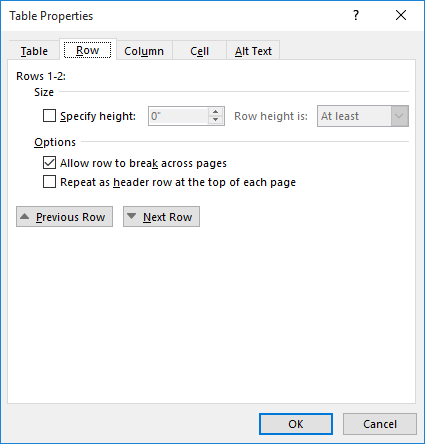Please Note: This article is written for users of the following Microsoft Word versions: 2007, 2010, 2013, 2016, 2019, and 2021. If you are using an earlier version (Word 2003 or earlier), this tip may not work for you. For a version of this tip written specifically for earlier versions of Word, click here: Keeping Table Rows Together.
Written by Allen Wyatt (last updated April 2, 2024)
This tip applies to Word 2007, 2010, 2013, 2016, 2019, and 2021
You may believe that you can keep table rows together if you select the text in a row and then choose Keep Lines Together from the Line and Page Breaks tab of the Paragraph dialog box. This is a common trick that you can read about in lots of places—including the pages of WordTips. What you may not know is that choosing this option may not always give the desired result.
The reason is that Word apparently ignores this setting within tables. (Astounding, isn't it?) Instead, Word pays attention to a setting in the Tables dialog box. If you look at the Row tab of the Table Properties dialog box, you see a check box entitled Allow Row to Break Across Pages. This is the only option that controls whether a page can break in the middle of a row. If the option is not set (the check box is clear), then the row won't break, regardless of the Keep Lines Together setting. Conversely, if the option is set, then the row can break, even if that means splitting up the paragraph text within the row. (See Figure 1.)

Figure 1. The Row tab of the Table Properties dialog box.
Upon reflection, you might think there is method to this madness. After all, the setting in the Paragraph dialog box should only affect paragraphs, and the setting in the Tables dialog box should affect tables. Under this logic, however, you would expect that if a table cell contains a long paragraph (10 or 12 lines), and the page break is going to occur in the middle of the paragraph, that the Keep Lines Together setting would still keep the single paragraph together. Unfortunately, it doesn't. Word still pays attention to only the Allow Row to Break Across Pages setting.
WordTips is your source for cost-effective Microsoft Word training. (Microsoft Word is the most popular word processing software in the world.) This tip (3590) applies to Microsoft Word 2007, 2010, 2013, 2016, 2019, and 2021. You can find a version of this tip for the older menu interface of Word here: Keeping Table Rows Together.

Learning Made Easy! Quickly teach yourself how to format, publish, and share your content using Word 2021 or Microsoft 365. With Step by Step, you set the pace, building and practicing the skills you need, just when you need them! Check out Microsoft Word Step by Step today!
Tired of that old table taking up space in your document? You can get rid of it using a variety of techniques, some of ...
Discover MoreWhen working with tables, a common editing task is to combine two tables into one. Sometimes, though, you may run into ...
Discover MoreWhen you move information from one table to another, you may be faced with the problem of making that information fit ...
Discover MoreFREE SERVICE: Get tips like this every week in WordTips, a free productivity newsletter. Enter your address and click "Subscribe."
2019-11-19 15:50:29
JESSICA DAVIS
Word does honor keep-with-next attributes, so if you allow a row to break, you can control the break point to some degree. However, I prefer not to break rows across pages because doing so could cause a reader to flip pages back and forth or have to scroll up and down to see the full content of a cell, which interrupts cognition.
Got a version of Word that uses the ribbon interface (Word 2007 or later)? This site is for you! If you use an earlier version of Word, visit our WordTips site focusing on the menu interface.
Visit the WordTips channel on YouTube
FREE SERVICE: Get tips like this every week in WordTips, a free productivity newsletter. Enter your address and click "Subscribe."
Copyright © 2026 Sharon Parq Associates, Inc.
Comments